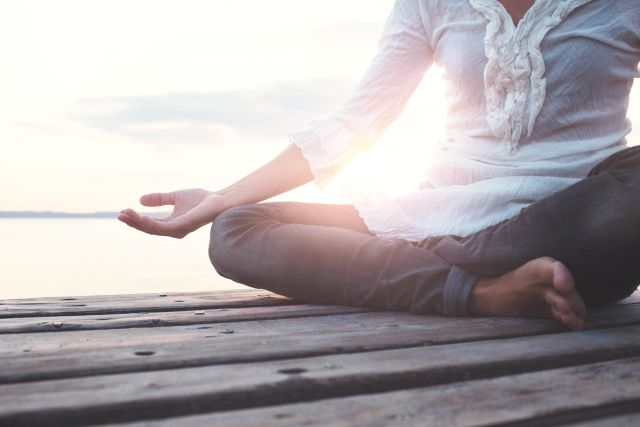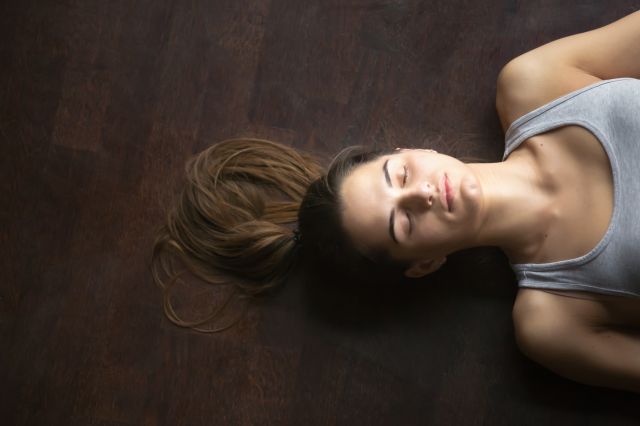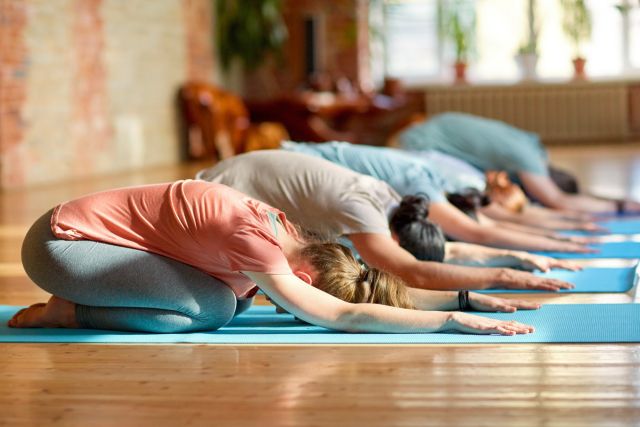This article is the third in a series on mindful leadership from expert and consultant Puja Madan. To understand what “mindful leadership” is and why it’s critical for your organization, read this article. To find out how to make meditation work for you, keep reading.
One of the most common questions I get at trainings and talks is: “What’s the difference between meditation and mindfulness?” Is it a tomato-tomato kind of difference or is there more to it?
Well, both meditation and mindfulness are different—but complementary. Here’s how we talk about them at The Mindfulness Map:
- Mindfulness is the practice of attending fully to the present moment. It’s a state of being highly self-aware in the here and now and our ability to pay attention to thoughts, feelings, and actions in a non-judgmental way. Mindfulness can be practiced anywhere, anytime, and with anyone (the other person doesn’t even need to know).
- Meditation is practiced for a period of time with specific techniques and usually has a fixed pattern and style.
Meditation nurtures our capacity to become more mindful. In turn, mindfulness supports and deepens meditation. Our focus today is to explore the world of meditation and learn the most useful ways each of us can meditate (even those of us who’ve struggled with it in the past).
 The Benefits of a Meditation Practice
The Benefits of a Meditation Practice
Although meditations have been practiced in the East for thousands of years, the practice has recently begun to make inroads into the Western world. And, simply put, meditation is the ultimate friend with benefits.
Studies show a regular meditation practice does wonders for the physical, emotional, and mental health of individuals, especially leaders. CEOs Mark Bertolini, Jeff Weiner, and John Mackey are among many who regularly practice meditation. Billionaire investment banker Ray Dalio has been meditating for over forty years (thanks, Beatles!) Oprah does it and even politicians like Congressman Tim Ryan and Senator Cory Booker are fans.
So what kind of benefits can you expect from your friendship with meditation? Meditation can:
- Reduce stress
- Alleviate pain
- Lower blood pressure and cortisol
- Improve digestion and immune system function
- Help manage mental health, especially anxiety and depression
- Improve productivity
- Facilitate clarity and focus
- Infuse a new shot of energy
- Improve decision making
- Bring a fresh, innovative perspective to issues
- Create calm and connectedness
- Encourage big-picture thinking
- Cultivate compassion, gratitude, and generosity
- Keep the ego in check
The bottom-line: a regular meditation practice can significantly improve our well-being and our capacity to be mindful throughout the day.
So Many Meditation Styles — Where to Begin?
While many successful leaders and C-suite managers attribute their success and sanity to meditation, many leaders I speak to struggle to maintain a regular practice. The reason isn’t always lack of discipline or commitment.
The reason is this: each individual meditates differently. And unless people find the meditation styles that work perfectly for them, they aren’t able to commit to a regular practice. I often joke that finding the right meditation technique is akin to finding Prince(ess) Charming — you have to kiss many frogs before you find “the one.”
While I was in India, I learned over a hundred meditation styles, each designed to cultivate different aspects of my being. But you don’t have to learn, experiment, and sort through those hundred like I did. In this article, I’ll cover a fundamental few meditation styles that are easy to access and incorporate into daily life.
1. Insight or Vipassana Meditation
A simple, but effective and technique is called Insight or Vipassana meditation, one of Buddha’s many gifts to us. Vipassana invites us to sit in an undisturbed space and begin bringing our attention to our breath, focusing on either the in-and-out breath at the nose or the belly.
By watching our breath, we are able to bear witness to every sensation in our body, every passing thought and feeling. By allowing this space within us, we allow ourselves to gain an insight into what is “real.” Slowly, this can become a way of life, where we begin to witness everything around us as though we are a neutral third party—from our walking, to eating, to working around others.
If this practice feels hard at first (it can be for many who lead sedentary lives and develop stress and pent-up energy in their bodies and minds from being mentally over-active and physically inactive), here’s a variation from Thich Nhat Hanh, the Zen Buddhist monk and author. He recommends the following poem as a way to work with the breath while setting intentions for ourselves.
You can practice it right now. Just sit comfortably and begin slowly reading the verses below, following their instruction:
Breathing in,
I know I am breathing in.
Breathing out,
I know I am breathing out.
Breathing in,
I see myself as a flower
Breathing out,
I feel fresh
Breathing in,
I see myself as a mountain
Breathing out,
I feel solid
Breathing in,
I see myself as still water
Breathing out,
I reflect things as they are
Breathing in,
I see myself as space
Breathing out,
I feel free
This is a great way to start your day and it takes less than ten minutes. Repeat this poem five to ten times every morning for a week and see how you feel. If you find this exercise resonates with you, incorporate it in your daily schedule.
2. Movement Based Meditations
Like I mentioned earlier, silent sitting meditation styles can be challenging in this day and age. During Buddha’s time, people were heavily involved in farming practices, working the land all day, returning exhausted and without much energy for over-thinking things. To sit and practice Vipassana was much easier then.
Today, most of our jobs require us to sit all day and be mentally engaged. We also consume copious amounts of information via the Internet that evoke a host of thoughts and feelings within us. It’s more challenging to sit down, close the eyes, and focus on the breath when the mind is distracted, frazzled, and overwhelmed.
 Movement-based meditations are excellent for releasing pent-up stress from the body-mind. Leaders who practice movement-based meditations experience an immense freedom, joy, and lightness in their body and mind as a result of these techniques:
Movement-based meditations are excellent for releasing pent-up stress from the body-mind. Leaders who practice movement-based meditations experience an immense freedom, joy, and lightness in their body and mind as a result of these techniques:
- Walking meditation, also called kinhin in the Zen tradition invites us to walk slowly (at least half the speed we usually walk if not slower) and intentionally, bringing our awareness to our feet touching the ground, while keeping self-awareness on the rest of body and mind. A large corridor or park is a great place to do this.
- Tai Chi and Qi Gong, both founded in China are physical mental and spiritual practices rolled into one. They both are designed to align our chi (lifeforce energy) in the body and mind.
- Yoga Asana, the physical movement aspect of Yoga, is also an invitation to bring our full awareness to the present moment, our body, mind, and heart.
- Active meditations, such as Osho’s active meditations or those from the Kundalinin Yoga tradition, are also powerful ways of reuniting with our creative life force energy by releasing stress and getting back in alignment.
- Of course, this list wouldn’t be complete if it didn’t include dancing as a form of movement-based meditation. The invitation being to remain aware and witness as you lose yourself to the rhythm.
Different movement-based meditations will resonate with different people, so you may want to pick one at a time and experiment to see which calls to you. Look for classes on MeetUp or Yelp in your area. Osho’s meditations can be found online.
3. Guided Meditations
Guided meditations are a great way to start your meditation practice. They usually are a combination of soothing music and gentle voices that guide us through specific issues: healing, stress relief, spiritual growth, and many others.
Typically, guided meditations begin with relaxing our minds and bodies, then include affirmations or visualization techniques that allow us to release the negative thought-patterns our subconscious might be holding onto. Over time, these thought patterns begin to dissolve, allowing us to experience calm, clarity, and a more positive outlook toward life.
There are many apps that offer a variety of guided meditations such as Calm and Headspace.
5 Tips to Develop a Regular Meditation Practice
- Patience: take your time to explore and experiment with different meditation practices until you find “the one.”
- Consistency: even if you meditate once a week, make sure you show up on that day and meditate.
- Comfort: make sure your space, clothing, and environment support your meditation practice.
- Sleep: it’s harder to meditate when you’re sleepy. Get enough sleep into your routine to have the best meditation experience.
- Openness: keeping an open mind and heart free of expectation can yield great results.
We’ll get practical next week as we explore another area of leadership that is enhanced significantly through mindfulness: time management. And if you missed last week’s article on how leaders can learn to handle “power stress,” click through to read here.





